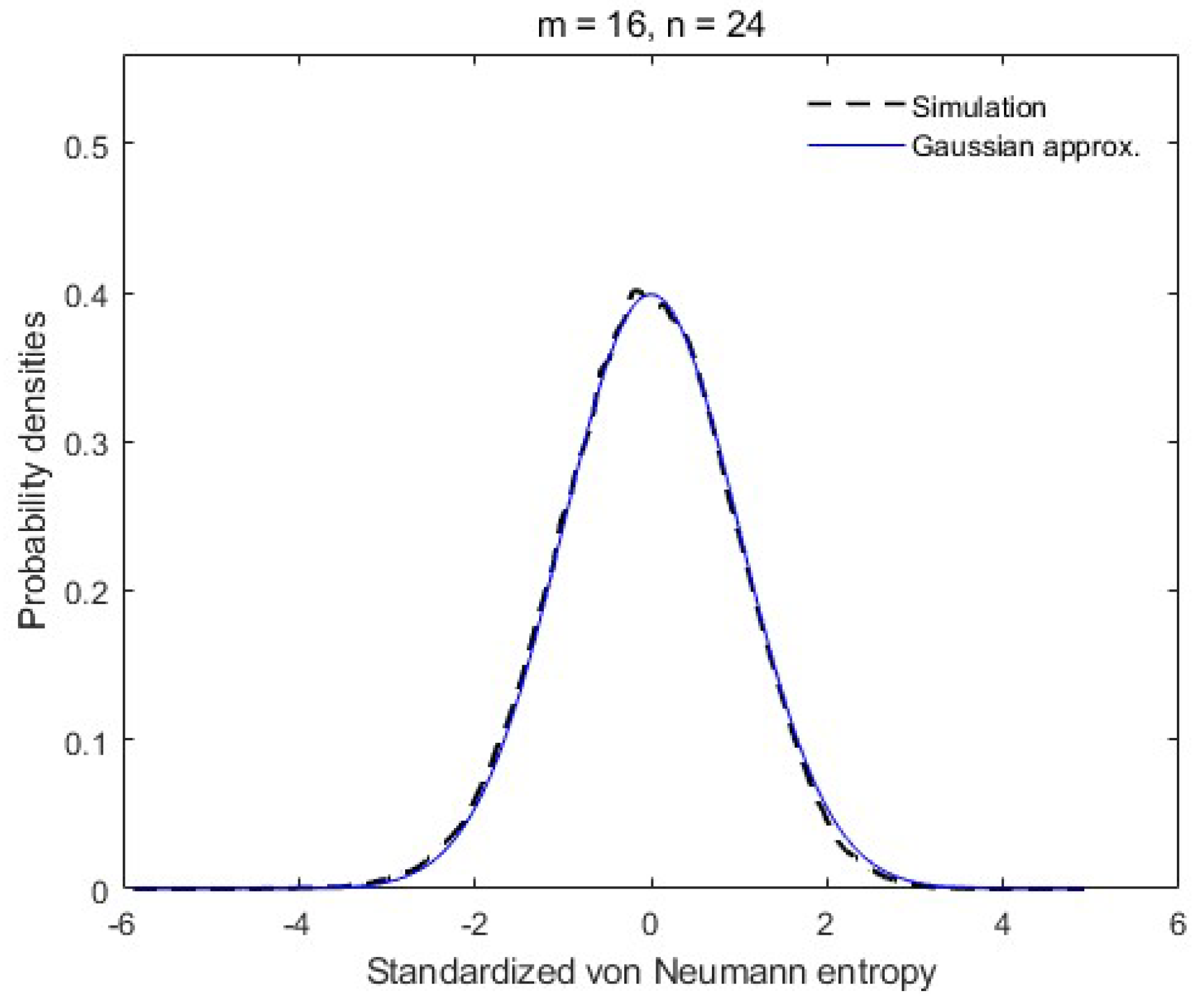Submitted:
10 August 2023
Posted:
10 August 2023
You are already at the latest version
Abstract
Keywords:
1. Introduction and Main Results
1.1. Square Root Spectrum and Applications
1.2. Description of Bures-Hall Ensemble
1.3. Main Results
2. Computing Moments of Sum of Square Root Statistics
2.1. Ensemble Conversion
2.2. Calculation of the Mean of
2.3. Calculation of the Second Moment
2.3.1. Calculation of and
2.3.2. Calculation of and
2.3.3. Calculation of
3. Conclusions
Acknowledgments
References
- Vidal, G.; Werner, R.F. Computable measure of entanglement. Phys. Rev. A 2002, 65, 032314. [Google Scholar] [CrossRef]
- Zhu, H.; Hayashi, M.; Chen, L. Axiomatic and operational connections between the l1-norm of coherence and negativity. Phys. Rev. A 2018, 97, 022342. [Google Scholar] [CrossRef]
- Jozsa, R. Fidelity for Mixed Quantum States. Journal of Modern Optics 1994, 41, 2315–2323. [Google Scholar] [CrossRef]
- Laha, A.; Kumar, S. Random density matrices: Analytical results for mean fidelity and variance of squared Bures distance. Phys. Rev. E 2023, 107, 034206. [Google Scholar] [CrossRef] [PubMed]
- Akemann, G.; Baik, J.; Di Francesco, P. (Eds.) The Oxford Handbook of Random Matrix Theory; Oxford University Press: United Kingdom, 2011. [Google Scholar] [CrossRef]
- Bengtsson, I.; Zyczkowski, K. Geometry of Quantum States: An Introduction to Quantum Entanglement. Geometry of Quantum States: An Introduction to Quantum Entanglement 2006. [Google Scholar] [CrossRef]
- Zhu, H.; Hayashi, M.; Chen, L. Axiomatic and operational connections between the l1-norm of coherence and negativity. Phys. Rev. A 2018, 97, 022342. [Google Scholar] [CrossRef]
- Hall, M.J. Random quantum correlations and density operator distributions. Physics Letters A 1998, 242, 123–129. [Google Scholar] [CrossRef]
- Zyczkowski, K.; Sommers, H.J. Induced measures in the space of mixed quantum states. Journal of Physics A: Mathematical and General 2001, 34, 7111. [Google Scholar] [CrossRef]
- Sommers, H.J.; Zyczkowski, K. Bures volume of the set of mixed quantum states. Journal of Physics A: Mathematical and General 2003, 36, 10083. [Google Scholar] [CrossRef]
- Wei, L. Exact variance of von Neumann entanglement entropy over the Bures-Hall measure. Phys. Rev. E 2020, 102, 062128. [Google Scholar] [CrossRef] [PubMed]
- Huang, Y.; Wei, L. Second-order statistics of fermionic Gaussian states. Journal of Physics A: Mathematical and Theoretical 2022, 55, 105201. [Google Scholar] [CrossRef]
- Page, D.N. Average entropy of a subsystem. Phys. Rev. Lett. 1993, 71, 1291–1294. [Google Scholar] [CrossRef] [PubMed]
- Wei, L. Proof of Sarkar–Kumar’s conjectures on average entanglement entropies over the Bures–Hall ensemble. Journal of Physics A: Mathematical and Theoretical 2020, 53, 235203. [Google Scholar] [CrossRef]
- Bertola, M.; Gekhtman, M.; Szmigielski, J. Cauchy–Laguerre Two-Matrix Model and the Meijer-G Random Point Field. Communications in Mathematical Physics 2014, 326, 111–144. [Google Scholar] [CrossRef]
- Forrester, P.J.; Kieburg, M. Relating the Bures Measure to the Cauchy Two-Matrix Model. Communications in Mathematical Physics 2016, 342, 151–187. [Google Scholar] [CrossRef]
- Bertola, M.; Gekhtman, M.; Szmigielski, J. Cauchy–Laguerre Two-Matrix Model and the Meijer-G Random Point Field. Communications in Mathematical Physics 2012, 326, 111–144. [Google Scholar] [CrossRef]
- Prudnikov, A.; Brychkov, Y.; Marichev, O. Integrals and Series. Volume 3: More Special Functions.; 1989.


Disclaimer/Publisher’s Note: The statements, opinions and data contained in all publications are solely those of the individual author(s) and contributor(s) and not of MDPI and/or the editor(s). MDPI and/or the editor(s) disclaim responsibility for any injury to people or property resulting from any ideas, methods, instructions or products referred to in the content. |
© 2023 by the authors. Licensee MDPI, Basel, Switzerland. This article is an open access article distributed under the terms and conditions of the Creative Commons Attribution (CC BY) license (http://creativecommons.org/licenses/by/4.0/).




